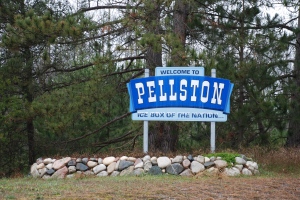Earlier this month I headed west for a quick weekend to visit The City of Roses, more commonly knows as Portland, Ore. The plan was to spend a couple of relaxing days visiting vineyards/wineries and exploring the natural beauty of the region.
Oregon grapes, the Columbia River Gorge and Multnomah Falls did not disappoint. But unfortunately the welcome sign for Salem, the state’s capital, did.
My first stop after landing at Portland International Airport – even before wine tasting – was Salem. With a metropolitan area home to nearly 400,000 people – ranking as the second-largest region in the state – Salem has served as Oregon’s capital city since 1851 when it was still the Oregon Territory.
Overcast skies clouded the day, but the biggest letdown came when I spotted the first sign. After years of photographing welcome signs, I have developed uncanny instincts in terms of where they will be located, and the Salem sign was waiting for me immediately after I exited Interstate 84. I pulled over in the parking lot of a Jack in the Box restaurant (you may notice the sign in the background) and walked across the street to safely take the photo.
I’m not sure I need to dwell too much on why this sign is such a disappointment, so I’ll make this brief. First and foremost, it doesn’t say welcome. A close second is the graffiti which makes it extremely difficult for me to imagine enjoying Salem. Third, the sun is high above the city; this is simply wishful thinking given that Salem averages nearly 300 cloudy or partly cloudy days per year. Overall, it’s a half-hearted attempt to represent the city’s “skyline”, the Willamette River and nearby national and state forests. It’s simply a sad sign.
Since I’d traveled all that way, I decided to make my way the short distance into central Salem to take a look at the Oregon State Capitol, something that has become a part of my routine when I visit state capitals. The building was constructed in the late 1930s as reflected in the Art Deco style.
The marble exterior is beautiful and the building itself exuded elegance that I did not experience in other parts of the city. Atop the Capitol is the Oregon Pioneer. Built by a sculptor in New Jersey, the Oregon Pioneer actually made his way to Salem via the Panama Canal, quite a different route than the earlier pioneers the sculpture represents.
In addition the building itself, I also liked the relief sculptures on either side of the main entrance (below). The first photo depicts Meriwether Lewis, William Clark and Sacagawea, and the second shows pioneers and a covered wagon.
As I headed out of town via a different route, I kept my eyes peeled for another sign, perhaps one that had not been marred by graffiti. My instinct paid off.
Turns out, this was a completely different sign, which is quite unusual. It’s common to have signs at multiple entrances to a location, but rarely are the signs different in shape, style and character. One thing was consistent – the same Enjoy Salem wording.
Even though this sign doesn’t have graffiti, it’s not really any better than the first sign. It’s bland, lifeless and downright… boring. The cursive script is on the homepage of the City of Salem’s Web site, so it must be the city’s official font. What’s perhaps most disappointing is that in a city with two different “welcome” signs, neither one has any good qualities.
Up next… Olympia, Wash. It couldn’t be any worse than Salem, right?















